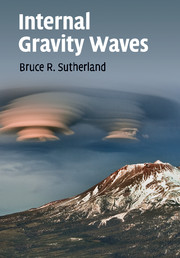4 - Nonlinear considerations
Published online by Cambridge University Press: 05 October 2014
Summary
Introduction
The linear theory calculations performed so far have the advantage that analytic solutions can be found for a broad range of circumstances. However, the solutions are strictly valid only in the limit of infinitesimally small amplitude waves. Waves are said to be weakly nonlinear when their amplitude is sufficiently large that nonlinear effects arising from the advection terms in the material derivative begin to play an important role. Using perturbation theory, simplified equations can be derived that capture the leading-order nonlinear effects, referred to as ‘weak nonlinearity’. Analysis of such equations not only reveals how nonlinear effects change the evolution of the waves, but they serve to establish bounds on the wave amplitude for which linear theory is valid.
As well as modifying the structure of small-amplitude waves, nonlinear effects can give rise to new classes of steady waves, such as solitary waves, and they can result in the breakdown of steady waves through mechanisms such as modulational instability and parametric subharmonic instability.
In this chapter we focus primarily upon the weakly nonlinear dynamics of interfacial and internal waves in otherwise stationary fluid; there is no ambient mean flow. For those not familiar with perturbation theory for differential eigenvalue problems, we begin with a brief review of the mathematics necessary for the treatment of weakly nonlinear waves. This analysis shows that frequency is a function of amplitude as well as wavenumber. We then examine how weakly nonlinear effects modify the evolution of interfacial and internal waves.
- Type
- Chapter
- Information
- Internal Gravity Waves , pp. 213 - 261Publisher: Cambridge University PressPrint publication year: 2010



